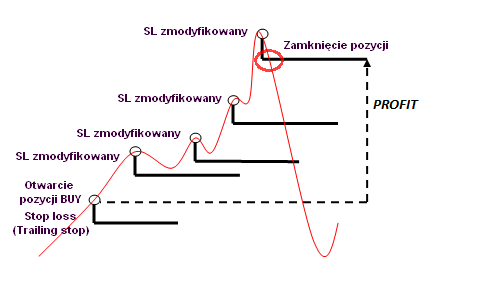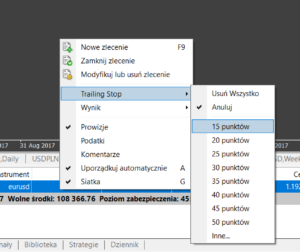Trailing Stop Loss - why and when to use it
Many traders believe that Stop Loss is essential when trading on Forex market. Adequate securing of the transaction, and consequently also risk management through a well-thought-out placement of defense orders, is often a decisive factor for success. But there are also opponents of SL claiming that it is exposing ourselves to the risk of premature closing of the position (additionally with a loss, even though we chose the direction correctly), or that in this way we reveal the market (and the broker) too valuable information that they can use to our disadvantage (so-called SL cutting). Both camps are right. Rolling Stop Loss is much less controversial and relatively not popular. That is why we decided to introduce you to this topic and dispel a number of doubts.
Rolling stop loss - what it is and how it works
Stopping Loss, or Trailing Stop (abbreviated as TS), is an order that is not designed to protect us from loss, but rather to gradually secure the profit generated by us. There are at least three rules for its operation.
# 1 - Trailing Stop - classic version
The most common is the method that assumes that the TS is activated when it is determined by the position of the indicated profit in the TS parameter. For example, by setting the TS on the 20,0 pip, it means that it will become active only when our position brings a profit of + 20,0 pips. The effect of this situation is to set the Stop Loss order to the position's opening level. If we now pass the SL, we will end the trade with the 0,00 pip balance.
But what happens if our profit continues to grow? With each successive pip pipeline SL will be shifted towards profit, and so with Profit + 21,0 pips, SL = 1,0 pips, with profits + 25,0 pips, SL = 5,0 pips, and so on.
In case of a withdrawal, the course of course stays in place.
# 2 - Trailing Stop - Dukascopy version
A slightly different principle of the rolling stop loss can be found, for example, on the JForex platform Dukascopy. The method of modifying the SL order is identical, but the condition for its activation differs. If we set the TS parameter to 20,0 pips, the future profit on our position will not matter. The set 20,0 pips is the distance that has to be traveled from the moment of setting the TS to activate it. This means that if we add TS = 20,0 when our position profit is +5,0 pips, TS will start working from the profit +25,0 pips (in the classic version # 1 it would be +20,0 pips).
However, further modification takes place as standard with the XFUMX developed pip.
# 3 - Trailing stop - manual version
Of course, we can do the same thing ourselves by moving our SL by hand. Thanks to this, we gain the ability to precisely modify the SL levels at the moment we choose and the distance we choose. However, on the other hand, we have to watch the platform all the time. Something at the expense of something. Which version is better? This will be determined by your personal preferences.

The principle of Trailing Stop operation
One thing is for sure. Trailing Stop in the versions built into the platform is a great convenience for the trader. Thanks to it, he does not have to monitor his position all the time. It may simply rely on automating the process of securing some of the profits earned.
Trailing Stop on Forex platforms
The vast majority of Forex platforms are equipped with Trailing Stop. However, it should be remembered that most of this majority also requires leaving the computer (and the platform connected to the internet) on, so that our Stop Loss is automatically modified (it remains active). This is the case, for example, with the MetaTrader 4 and 5 platforms. However, there are platforms that store the TS parameter settings on the broker server side (eg xStation xNUMX, cTrader). Thanks to this we can turn off the application and not worry that our SL will not be further changed. This is a great convenience.
You can also use non-standard tools in the form of Expert Advisors (EA) or combine harvesters to use SL. It has its important advantages as well as disadvantages.
Benefits…
First of all, the advantage is the ability to define the jump parameter (or step), which is the distance at which TS will modify our Stop Loss. Thanks to this we can set TS = 10, but Step = 5. As a result, our Stop loss will be modified in steps by + 10,0 pips, + 15,0 pips, + 20,0 pips, and so on. Platforms are very rarely equipped with this option as standard (it has eg cTrader).
and disadvantages
The disadvantage is the need to manage an additional tool, i.e. a machine or combine. We must remember that using a custom TS all parameter changes must take place there, and exactly on the computer on which it was run. It reduces our mobility (the solution is equip yourself with VPS). In addition, the risk of correct operation of this tool is already on our side and is not subject to any complaints that we could make to the broker.
When using the Trailing Stop, we need to remember one more important thing. The platform must have time to react and modify our Stop Loss. It may often be too short to jump a second upwards for the TS mechanism to react. As a consequence, our SL will stay in its place, although the chart should be different.
| Platform | MetaTrader 4 | MetaTrader 5 | JForex 3 | xNUMX xStation | cTrader |
| TS version | # 1 - classic | # 1 - classic | # 2 - Dukascopy | # 1 - classic | # 1 - classic |
| TS on the broker server | No | No | *Yes | Roof | Roof |
| Parameter Step (step) | No | No | No | No | Roof |
| EA support / programming | Yes / MQL4 | Yes / MQL5 | Yes / Java | No / - | Yes c# |
* using the Remote function
Ways of selecting the Trailing Stop parameter
We have the last issue left to discuss: when is it worth using a Trailing Loss and how to choose the appropriate value for this order.
Strengths and weaknesses of TS
First of all, we must be aware of the strengths and weaknesses of Trailing Stop. The strong fact is that our profit is hedged continuously until the SL breakout, TP is reached or the transaction is closed manually. This means that an unplanned change of direction protects us from being left with nothing or ending the transaction with a loss. In other words, our effectiveness increases. Unfortunately, on the other hand, a temporary pullback can throw us off the market, even if we finally took the right direction and there was no risk of hitting the stop loss originally set by us.
So we have a situation where we will more often close the position with a small profit, and less often we will achieve the target target. Ultimately, in the long run, this should reduce the level of our capital withdrawal (drawdown), but it can also reduce our total profit.

Trailing Stop and strategy
The trailing stop will not work well with all types of strategies. Hence, we must think carefully whether we really need it. Systems based on limited range moves or a game of consolidation are unlikely to need TS. Rarely, it will also be useful for scalping. Taking the risk of entering into a transaction where the spread / commission has a large share of the possible loss. It makes the use of TS unprofitable and will lead to the fact that out of 10 transactions, 8 of them will end up with a balance sheet of 0, when we fought for 5-10 pips (and yet we paid the spread).
The largest use of mobile SL will be made using the trend-following strategy, day-trading, breaking games, news trading or other methods that are based on a longer or more dynamic price change in a given direction.
The exceptions from this group are strategies following the applied trend targeted at long-term. In this case, in my opinion, it is better to decide independently about moving SLs to key places than to seem to be rigidly introduced parameter.
Trailing Stop Loss - parameter selection
There are two popular ways to choose TS values:
# 1 - Based on correction
In this technique, we measure the last significant correction of the traffic to which we plan to connect. Set the TS parameter in its size + possibly increasing it by a small margin of error.
# 2 - Based on mean volatility (ATR)
The second method is based on average volatility, for which we use the ATR indicator or other tool that allows us to check the average range of price changes in a given period. The period in question is the key here. If we use day-trading, and we keep our position open most of the day, we should take into account the volatility of at least the last few days. If, on the other hand, we trade in the medium term, the period under consideration must cover at least a few weeks.






















![Forex Club – Tax 9 – Settle tax on a foreign broker [Download the Application] Forex Club - Tax 9](https://forexclub.pl/wp-content/uploads/2024/02/Forex-Club-Podatek-9-184x120.jpg?v=1709046278)
![Trading View platform – solutions tailored to the needs of traders [Review] trading view review](https://forexclub.pl/wp-content/uploads/2024/03/trading-view-recenzja-184x120.jpg?v=1709558918)
![How to connect your FP Markets account to the Trading View platform [Guide] fp markets trading view](https://forexclub.pl/wp-content/uploads/2024/02/fp-markets-trading-view-184x120.jpg?v=1708677291)
![How to invest in ChatGPT and AI? Stocks and ETFs [Guide] how to invest in chatgpt and artificial intelligence](https://forexclub.pl/wp-content/uploads/2023/02/jak-inwestowac-w-chatgpt-i-sztuczna-inteligencje-184x120.jpg?v=1676364263)


![WeWork – the anatomy of the collapse of a company valued at $47 billion [WeWork, part II] wework bankruptcy story](https://forexclub.pl/wp-content/uploads/2024/04/wework-bankructwo-historia-184x120.jpg?v=1711729561)
![Adam Neumann – the man who screwed up Softbank [WeWork, part AND] adam neumann wework](https://forexclub.pl/wp-content/uploads/2024/04/adam-neumann-wework-184x120.jpg?v=1711728724)





![How to transfer shares to another brokerage office [Procedure description] how to transfer shares to another brokerage house](https://forexclub.pl/wp-content/uploads/2024/03/jak-przeniesc-akcje-do-innego-biura-maklerskiego-184x120.jpg?v=1709556924)

![The most common mistakes of a beginner trader - Mr Yogi [VIDEO] Scalping - The most common mistakes of a beginner trader - VIDEO](https://forexclub.pl/wp-content/uploads/2024/03/Scalping-Najczestsze-bledy-poczatkujacego-tradera-VIDEO-184x120.jpg?v=1711601376)
![Learning patience: No position is also a position - Mr Yogi [VIDEO] Scalping - Learning patience - No position is also a position - VIDEO](https://forexclub.pl/wp-content/uploads/2024/03/Scalping-Nauka-cierpliwosci-Brak-pozycji-to-tez-pozycja-VIDEO-184x120.jpg?v=1710999249)
![When to exit a position and how to minimize losses - Mr Yogi [VIDEO] Scalping - When to exit a position and how to minimize losses - VIDEO](https://forexclub.pl/wp-content/uploads/2024/03/Scalping-Kiedy-wyjsc-z-pozycji-i-jak-minimalizowac-straty-VIDEO-184x120.jpg?v=1710336731)







![Building a risk management plan - How to do it? [Guide] risk management](https://forexclub.pl/wp-content/uploads/2021/12/zarzadzanie-ryzykiem-300x200.jpg?v=1639495023)
![Automatic Stop Loss on MetaTrader 5 - how to do it? [Video] auto-stop-loss-mt](https://forexclub.pl/wp-content/uploads/2021/11/auto-stop-loss-mt-300x200.jpg?v=1637831541)











